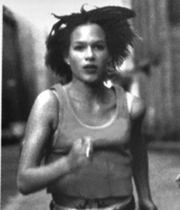


Run Lola Run
****
Run Lola Run, the concluding film of the Allen Art Museum's German Film Series, is an action-packed race against the clock, times three. Nominated for the 1999 Academy Award for "Best Foreign Film," and the highest-grossing German film ever, this tour-de- force of a film is a product of the New German Cinema, breaking conventions of all sorts while immersing the viewer in a total "cinema of experience." Lola flows like a fast-paced music video, while at times feeling like a video game that, despite its redundancy, keeps the viewer glued to the screen at all times.
The premise is simple enough: Lola (Franka Potente), receives a call from her boyfriend, Manni, (Moritz Bleibtreu), who is in dire need of 100,000 Deutsche Marks after a drug deal mishap. The catch is that he needs it immediately, within 20 minutes, or he will suffer the dire consequences. What Lola sees in this whining loser of a boyfriend is a mystery, yet she loves him and tells him to stay where he is -- she will be at the phone booth 20 minutes. So she runs and keeps on running in search of 100,000 DM. Lola is a site to see as she bolts breathlessly throughout the streets of Germany, past nuns, bicycle peddlers and nannies pushing strollers. Her flaming red hair blows violently in the wind as her tank top rises and falls, revealing her tattooed naval.
By dividing the film into thirds, each one beginning when Lola receives the call from Manni, filmmaker Tom Tykwer focuses on the difference each second of each day makes, and how minuscule changes of fate can have life-altering results. Tykwer provides three different scenarios of Lola's run through town, each with a vastly different ending. Run Lola Run, despite its simple, sometimes tedious plot, is an innovative masterpiece, thanks to its MTV-style visuals and special effects. European techno beats loudly and repetitively in the background as the screen switches back and forth from black and white to color, from digital to documentary, from flashback to future, from slow motion to animation, all in real time.
Critics may argue that Lola lacks substantial character development, or that there is no character of the viewer's interest. While this is true, Lola doesn't need character development. The film is all about living in the present moment and taking in stride all the action, motion and commotion that comes with each moment. Run Lola Run is unpretentious -- it simply is what it is, an eccentrically wild ride.
Copyright © 1999, The Oberlin Review.
Volume 128, Number 9, November 12, 1999
Contact us with your comments and suggestions.